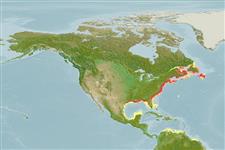Environment: milieu / climate zone / depth range / distribution range
Ekologi
laut; air tawar; payau dasar (demersal); anadromus (ruaya dari laut ke air tawar) (Ref. 51243); kisaran kedalaman 1 - 46 m (Ref. 4639). Subtropical; 56°N - 10°S, 102°W - 33°W (Ref. 54265)
Western Atlantic: Hamilton River, Labrador, Newfoundland, Canada to northeastern Florida, USA. Occurs occasionally in Bermuda and French Guiana (Ref. 7251). Northern Gulf of Mexico (Ref. 26938). In Europe: Baltic Sea. Landlocked populations in Lakes Ladoga and Onega (Russia), both now extirpated. Occasionally recorded from Great Britain and North Sea in Elbe drainage (Ref. 59043). Recent research revealed that this species existed in the Baltic Sea, but is now extirpated (Ref. 83384, 83385). Near threatened globally, but extirpated in Europe (Ref. 59043).
Length at first maturity / Size / Weight / umur
Maturity: Lm 201.7, range 183 - 243.8 cm
Max length : 403 cm TL jantan/; (Ref. 26938); 430.0 cm TL (female); common length :250 cm TL (female); Berat maksimum terpublikasi: 0.00 g; Umur maksimum dilaporkan: 60 Tahun (Ref. 39404)
deskripsi pendek
Morfologi | Morfometrik
Duri punggung (Keseluruhan (total)): 0; duri punggung lunak (Keseluruhan (total)): 30-46; Duri dubur 0; Sirip dubur lunak: 22 - 32. Elongate fish, pentagonal in cross section and shark-like fins (Ref. 26938). Double row of pre anal shields. Presence of a soft fontanelle. Bony shields are oval. Carina on dorsal shields do not have a conspicuous hook. Head and back bluish-black and lower surface whitish (Ref. 37032). Snout long, sharply V-shaped. 2 pairs of short, slender barbels in transverse line midway between end of snout and anterior edge of mouth (Ref. 4639). Viscera pale (Ref. 7251). Presence of 4 small scutes, usually as 2 pairs between anal fin and caudal fulcrum (Ref. 86798).
Anadromous species. Occurs solitarily or in small groups; inhabits shallow waters of continental shelves. At the sea, it occurs in coastal and estuarine areas on soft bottom (Ref. 59043) down to a depth of 50 m (Ref. 89115). Adults are highly migratory while at sea (Ref. 57533) and make long migrations along the coast (Ref. 59043). Feeds on benthhic invertebrates such as mollusks, crustaceans and aquitic insects from the sediments (Ref. 93252). They forage mainly in brackish waters (Ref. 59043). Ascend large rivers to spawn (Ref. 59043). Juveniles may remain in fresh or brackish water until 2-5 years of age or 76-91.5 cm long (Ref. 4639, 59043). Today most individuals do not exceed 250 cm length. Tagging studies have shown that this species may move distances up to 1,450 km (Ref. 89119). Used smoked and fresh (Ref. 37032). Near threatened globally, but extirpated in Europe due to massive overfishing, damming, river regulation and pollution (Ref. 59043).
Matures at increasing ages with increasing latitude (Ref. 88171). Both sexes do not spawn yearly and spawning intervals may vary according to area. In the St. Lawrence River, males spawn every 1-5 years, females every 3-5 years (Ref. 89103). Adults from the sea begin to ascend the lower reaches of large rivers in spring with the majority ascending immediately prior to spawning. Spawning occurs between March and August (Ref. 59043), when water temperature is 13.3-17.8 °C (Ref. 89118). Spawning occurs over bedrock, boulders or gravel bottoms, in depths exceeding 10 m at current velocities of 0.5-0.8 m/s (Ref. 59043, 89103). Exact time of spawning depends on temperature (Ref. 26938). Per female 0.4-8 million eggs may be spawned (Ref. 45706, 84845, 89137). Eggs demersal, sticking to stones, measuring 2.55 mm in diameter and hatching in 1 week at 17.8 °C (Ref. 4639, 9980). Adults return to the sea after spawning (Ref. 59043). Sturgeons in general have a high capacity for hybridization and most species are able to cross-breed (Ref. 89103, 89117).
Page, L.M. and B.M. Burr, 1991. A field guide to freshwater fishes of North America north of Mexico. Houghton Mifflin Company, Boston. 432 p. (Ref. 5723)
Status IUCN Red List (Ref. 130435)
ancaman kepada manusia
Harmless
penggunaan manusia
Perikanan: komersial
informasi lanjut
AcuanBudidaya airprofil budidaya airStrainGenetikaElectrophoresesDiturunkanPenyakit-penyakitPengolahanNutrientsMass conversion
Alat, peralatan
laporan khas
muat turun XML
Sumber internet
Estimates based on models
Preferred temperature (Ref.
123201): 4.3 - 24.4, mean 17.3 °C (based on 268 cells).
Phylogenetic diversity index (Ref.
82804): PD
50 = 0.5000 [Uniqueness, from 0.5 = low to 2.0 = high].
Bayesian length-weight: a=0.00324 (0.00142 - 0.00736), b=3.17 (2.99 - 3.35), in cm total length, based on LWR estimates for this Genus-body shape (Ref.
93245).
Trophic level (Ref.
69278): 3.4 ±0.50 se; based on food items.
Daya lenting (Ref.
120179): sangat rendah, Waktu penggandaan populasi minimum lebih dari 14 tahun (K=0.03; tm=7-34; tmax=60; Fec=1.03 million).
Fishing Vulnerability (Ref.
59153): Very high vulnerability (85 of 100).
